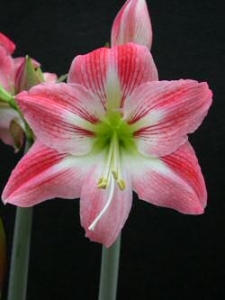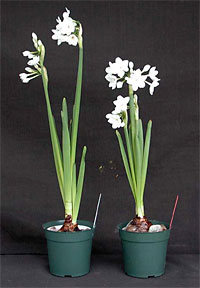Forcing Winter Beauty From Spring Bulbs

Amaryllis ‘Amourette’
Those of us of a certain age may remember an old TV commercial that warned, “It’s not nice to fool Mother Nature!” When it comes to getting through cold, dreary months, however, go ahead and fool her by forcing flower bulbs to bloom indoors. You can begin the process anytime from September to November; and if you start a few bulbs every few weeks, you can enjoy the beauty and fragrance of blooms in your home throughout the wintry season.
Choosing and storing bulbs
You can force many kinds of bulbs. Paperwhite narcissus and amaryllis are two of the easiest and most popular, especially for the winter holidays. These tender bulbs do not require precooling before planting. Hardy bulbs, however—such as other narcissus, tulips, daffodils, crocuses, scillas, hyacinths and grape hyacinths—must spend time in a cold area for a number of weeks.
In general, always look for bulbs that are large, firm and unblemished. Bulbs contain the unseen immature plant and their own food storage system, so a better quality bulb will usually produce a better plant.
If you are not planting your bulbs immediately, or if you plan to plant at intervals for continuous blooms, you can store the bulbs at 35 to 55 degrees F. Place them in a bag that will allow air circulation, such as a paper one with holes in it. Avoid plastic bags, as these retain moisture and cause mold. You can store bulbs in the refrigerator, but keep them away from fruits such as apples that produce a gas that can cause bulb-rot.
Planting pointers for hardy bulbs
Almost any type of container with holes in the bottom will work for forcing bulbs, although a plastic pot may hold moisture and cause the bulb to deteriorate. Choose a pot that is deep enough to hold soil below the bulb, allowing it to develop a good root system.
Bulbs require a light, airy, loose potting mix. You can use a soilless mix, or make your own with 60 to 70 percent sphagnum peat moss or coir, 10 to 30 percent perlite, and some optional vermiculite (up to 20 percent). You do not need to add fertilizer because bulbs store their own food.
When planting, do not bury the bulbs completely. For most bulbs, leave a small part of the pointed top of the bulb exposed. Space bulbs closer together than you would in the garden, and do not pack the soil around them. If you are planting tulips, plant them with the flat side facing out, as this will allow the leaves to grow in a more balanced manner. Water the bulbs right after planting and keep them evenly moist after that.
The big chill
Unless you can find precooled bulbs that are labeled as such, you will need to cool all hardy bulbs at 35 to 50 degrees F. (Remember, paperwhite narcissus and amaryllis aren’t hardy, so you do not need to precool them.) You will get the best results if you chill bulbs for 12 to 16 weeks, but the time can vary. If you do not chill them long enough, the stems and leaves may be stunted and will not fully develop. If you store your bulbs in a cool place after buying them, waiting for the optimal time to plant, factor in that time. Good locations for bulbs to chill include an unheated garage, a shed, a cold frame, or, the aforementioned refrigerator. If you do not have indoor space to cool bulbs, you can bury a planted pot outdoors, making sure water will drain from the bottom, so the pot does not sit in water. Mulch the top with straw or chopped leaves, piled on heavily.
Bringing the bulbs indoors
Once you have precooled the bulbs for the appropriate period of time, bring the pot indoors and place it in a sunny location that is less than 65 degrees F. A temperature of 50 to 60 degrees F is ideal for the first week or until you can see the shoots and leaves. At that point, move the pot into a warmer spot, but avoid placing it in direct sunlight. Keep the pot evenly moist. You should begin to notice shoots in two to eight weeks, depending on the type of bulb. To see when you might expect your bulbs to start blooming, see the chart in Fooling Mother Nature: Forcing Flower Bulbs for Indoor Bloom by Fairfax County Master Gardener, George Graine. This award-winning article contains in-depth information about forcing bulbs and many helpful references, including links to videos about the topic.
Once the bulbs have started blooming, moving the pot to a cooler location each night will result in a longer bloom period. Many bulbs will not flower again after you have forced them so most resources recommend throwing out the bulbs after they have finished blooming. However, you can try to plant them in your garden to get blooms the next year; this may work. The exception is the amaryllis which reblooms reliably with the proper care.

amaryllis
That special case: the amaryllis
Plant amaryllis bulbs a bit differently. They do best when they are pot-bound, with only an inch or two of soil around the bulb. You can use the same mix described above. One-third to one-half of the bulb should be above the soil. Place the bulb in a warm place—unlike hardy bulbs that will need to be cooled—and let the soil dry out slightly. Water it just once a week until the first shoots appear; then water more frequently. Rotate the pot every few days to keep the stems straight. Once the bloom appears, place the pot in a cooler spot each night to prolong the blooms.
As stated, amaryllis — unlike most other bulbs—can rebloom for years if properly stored during their dormant period. Once an amaryllis has finished blooming, place it in a sunny spot, and then move it outdoors in the summer. Fertilize it throughout the growing season. When fall arrives, stop watering, let the leaves fall off or cut them, and let the bulb rest for about two months. Move the plant inside to a cool, dark place, about 55 degrees F, for eight to 10 weeks, then pot it up again in fresh soil and start the process again.
Forcing bulbs in water

Paperwhites grown with and without alcohol
Narcissus can get leggy and fall over, requiring support to keep the flowers upright. You can prevent this by adding a small amount of rubbing alcohol to the water once you see the roots and green stem starting to form. Empty the water out of the container and replace it with a mixture of 1 part rubbing alcohol to 10 parts of water, using that instead of plain water as you continue to refresh the container.
If the smell of rubbing alcohol in the house during the winter holidays does not thrill you, you can use alcohol from many liquors instead. But do not use alcoholic beverages containing sugars. The proper ratios are recommended in the Cornell study, linked below.

Hyacinth in vase made for forcing indoors
Make sure that there is always water in the vase or bowl. Keep it in a cool (45 to 50 degrees F), dark place until you see roots, the tip grows to 3 to 4 inches, and the flower cluster emerges free from the bulb. This may take eight to 12 weeks. When the top growth is well-developed, move the glasses to a cool, bright window.
Enjoy the beautiful display you will get from one of the easiest of gardening activities!
References
Fooling Mother Nature: Forcing Flower Bulbs for Indoor Bloom, George Graine, Virginia Cooperative Extension
How to Make Your Amaryllis Bloom Again, U.S. National Arboretum
Forcing Bulbs for Indoor Bloom, University of Missouri Extension
Home Gardening Center Tip Sheet: Bulbs for Forcing, New York Botanical Garden
Forcing Bulbs Indoors, Clemson University Extension
Pickling Your Paperwhites, Flowerbulb Research Program, Cornell University